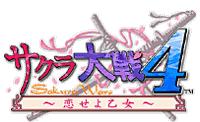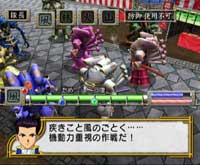|
|

|
BATTLE SYSTEM
|

|
INTERACTION
|

|
ORIGINALITY
|

|
STORY
|

|
MUSIC & SOUND
|

|
VISUALS
|

|
CHALLENGE
|
Pathetic
|
COMPLETION TIME
|
10-13 hours
|
|
OVERALL
3.0/5
|
Rating definitions
|
|
|
I profess no objectivity when it comes to Sakura Wars. 1, 2 and 3 I firmly believe to be the finest examples of the tactical-RPG meshed with anime-style plot development and mild dating elements that can exist. So assigning a much lower rating to Sakura Wars 4 is not something I do lightly. But something is off about the game, something major. Sure itís enjoyable to anyone with a liking for Sakura Wars, but it could have been so much more.
At the end of Sakura Wars 3 Ichiro Ohgami was sent back to Tokyo, where Sakura Wars 4 begins. There appears to be a problem with golden steam emanating throughout Tokyo. This golden steam has the nasty effect of making steam-powered machines (everything mechanical in this alternate world is powered by steam) go berserk. This eventually comes to include the Koubu with which Ohgami and the Teikokukagekidan go into battle. Could such an emergency require the aid of the Paris Kagekidan? Iíd better not spoil the suspense.
 This is what happens when American football is tried in Japan with the ubiquitous giant robots. Astroturf just doesnít hold up.
This is what happens when American football is tried in Japan with the ubiquitous giant robots. Astroturf just doesnít hold up.
|
|
The difficulty with the story here is that itís far too short. Everything happens too fast in the main story, with no room for any elements to steep. Every prior game had plenty of scenes with characters to give the player insight into them, along with enough enemy machinations to give a good grasp of what types the opponents were. Sakura Wars 4 has no major or even moderate moments to further develop characters Ė they all just do their things, and to a neophyte will be rather incomprehensible. The interesting casts of past villains are thrown out the window Ė two guys show up, have no lines, and die. Then the third guy, the main bad guy, appears after a few fleeting glimpses earlier on. Aside from a distinct Noh theater influence, I canít remember much about these villains. They just donít have enough screen time. And the rest of the plot is too hurried, at least in comparison to the past titles.
Outside of battle the game is exactly the same as Sakura Wars 3. Every innovation to the character interaction introduced in 3, as well as those from 2 and 1, remains here. But nothing is new. Ohgami interacts with the Teikokukagekidan and the other persons around the Teigeki in Tokyo, frequently having to answer their prompts with one of several options that are timed. Later in the game the Paris Kagekidan will also be on hand, meaning that Ohgami will have his hands full. Answers can change over time, Ohgami can witness events with other characters and decide whether to intervene or not, his answers can be influenced in strength by the analog stick, and at least once in my observation an overall time limit must be dealt with while still answering smaller queries that are also timed. A player of Sakura Wars 3 has seen it all before, however, with only the list of participants increased. The absence of minigames with the characters is displeasing, as the sole minigame here is hardly the twitch-game that would be appreciated and instead is a complex card game that I didnít understand.
Battle is blatantly copied from Sakura Wars 3, only with additional characters present using the battle system. Every character on the field has a gauge of 7 levels (although wise conversation choices by Ohgami can add a level or two). Movement, defense, attacking, itís all covered by the gauges. To move across the field will use up all the gauges with nothing left to attack or defend. Special attacks use one gauge level. Ohgami can change the battle strategy to allow defense, special charges, or recoveries (healing) to require more or fewer gauge levels. As a side note, due to plot exigencies (or is it the fact that no more than six Koubu were on the field simultaneously in Sakura Wars 3?) there will never be more than six Koubu on the field in Sakura Wars 4. The final battle presents the opportunity for the player to choose who will accompany Ohgami onto the field, forming the Ohgami Kagekidan. This is a memorable moment, but the game is nearly over by that point.
 Ack, this is completely unintuitive. Seriously people, this is the one minigame and it comes with six different instructional sets in Japanese. Good luck.
Ack, this is completely unintuitive. Seriously people, this is the one minigame and it comes with six different instructional sets in Japanese. Good luck.
|
|
Graphically Sakura Wars 4 looks identical to 3, save for some new special attacks (that use considerably less time and do not have their names in text onscreen to follow easily) and the presence of the Teikokukagekidan. Most of the out-of-battle screens appear to be reused from Sakura Wars 2 and 3, with only a few new ones added. The enemies are new, however.
Aurally Sakura Wars 4 is graced with top-quality voice acting. Somewhere between 2/3 and ĺ of the dialogue is voiced, and all of the actors do fine work. Save perhaps for the main bad guy, who seems to be emoting through a synthesizer to alter his voice. Music, on the other hand, suffers from a great deal of reuse. 90% of the music in Sakura Wars 4 was heard in the first three games, none of which reused music like this. Kouhei Tanaka does turn in a few new tunes that have a Noh feel, but reusing so much music (even high-quality music, which this is) cannot be ignored.
Even by Sakura Warsí gentle standards of difficulty, this game is easy. Enemies are very stupid, sometimes refraining from attacking a player-controlled character even if the character is standing right next to the enemy. The final boss presents something of a challenge, it is true, but nothing else does.
Sakura Wars 4 is incredibly short when compared to the grand stories of the previous titles. It can probably be completed in less than 10 hours. The avowed purpose of the Red development team was to promote Ďwidth, not depthí with this title, and that certainly is true, since Ohgami will have to decide his partner at the end of this game and has 13 possible choices. The problem here is that all the earlier Sakura Wars titles promoted heavy replay as well, and did so with stories that went on to the 40-hour range. Certainly there are plenty of character-specific events and dialogue in Sakura Wars 4, easily sufficient to prompt replay many times over. But the three prior titles achieved that with so much more.
It may appear that all my criticisms indicate a dislike of Sakura Wars 4. In fact I enjoyed it a great deal, as I enjoyed all previous Sakura Wars titles. But where the earlier games were fully formed, this one was spit out of Red in but a year, less than half the development time for the others. And as a farewell to the Tokyo and Paris casts, it could have been so much more. To a devotee of the series it still is recommended, but disappointment will be almost inevitable. A remake of this game, giving it a fully fleshed story and more time to allow character development, would be a great thing. Sadly, Michie Tomizawa (the seiyuu for Kanzaki Sumire) has retired, making that a very unlikely prospect. Sakura Wars 4 could have been so much moreÖ.
Review Archives
|









